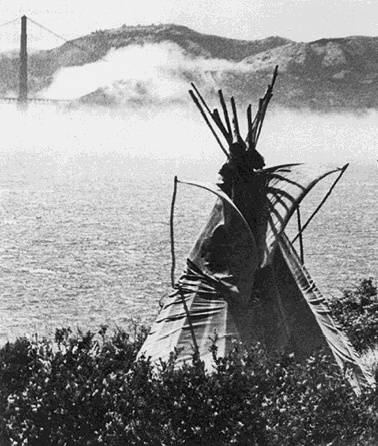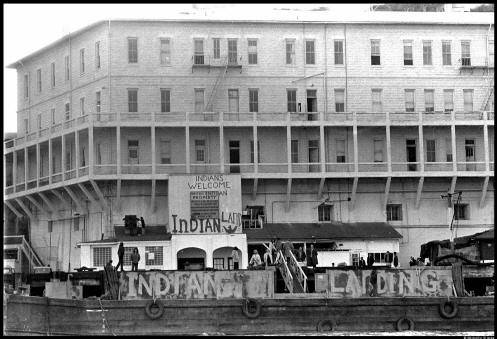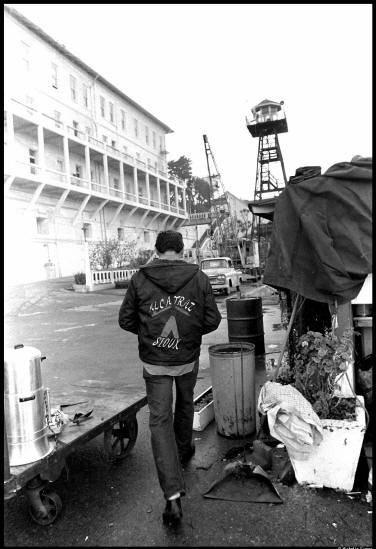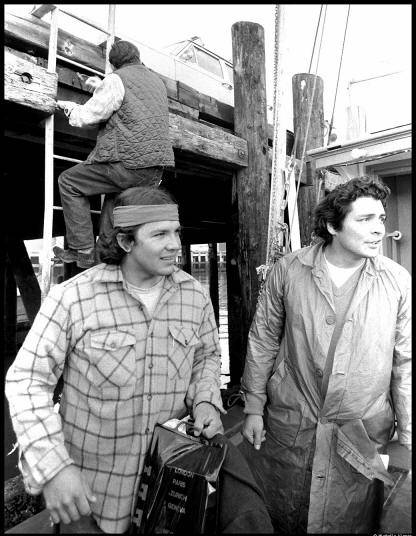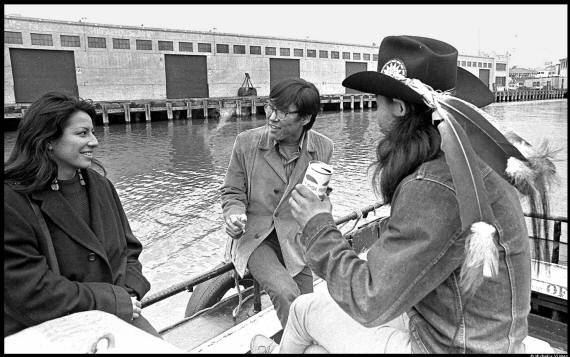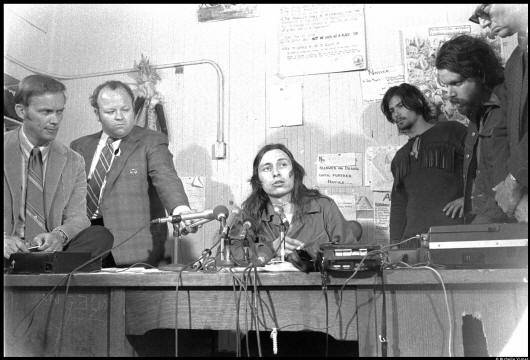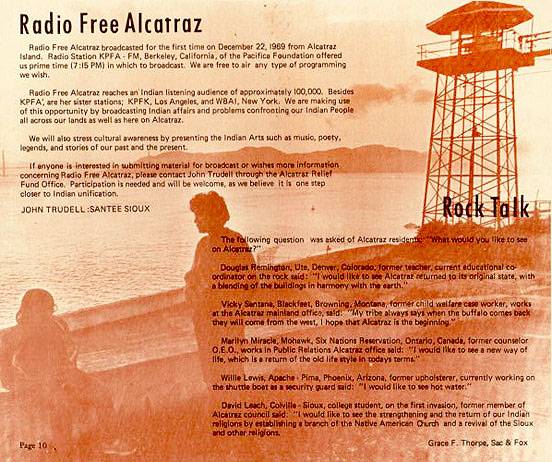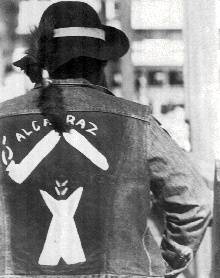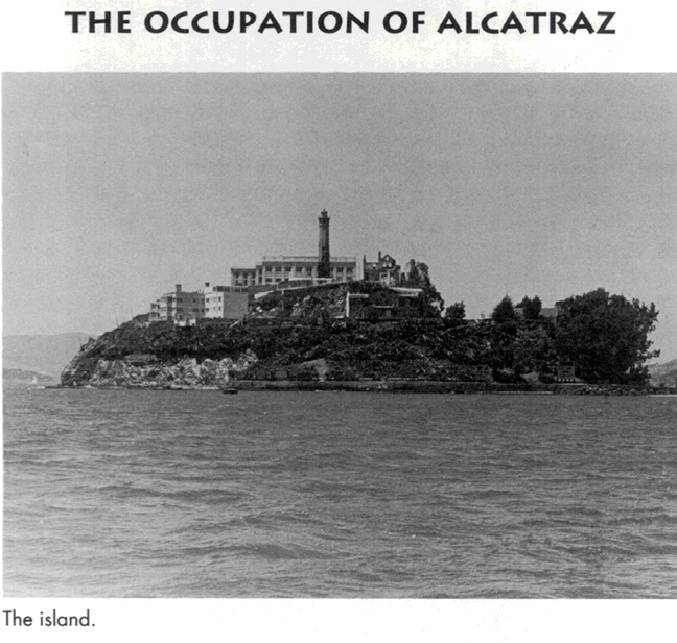The Indian Occupation of ALCATRAZ: Difference between revisions
(Addressing Injustice logo added) |
(linked to Bay Area Social Movements category) |
||
| Line 72: | Line 72: | ||
[[FROM ARIZONA TO ALCATRAZ: Hopi prisoners on Alcatraz |Prev. Document]] [[ALCATRAZ Proclamation |Next Document]] | [[FROM ARIZONA TO ALCATRAZ: Hopi prisoners on Alcatraz |Prev. Document]] [[ALCATRAZ Proclamation |Next Document]] | ||
[[category:Indigenous]] [[category:1960s]] [[category:1970s]] [[category:Dissent]] [[category:Fisherman's Wharf]] [[category:San Francisco outside the city]] | [[category:Indigenous]] [[category:1960s]] [[category:1970s]] [[category:Dissent]] [[category:Fisherman's Wharf]] [[category:San Francisco outside the city]] [[category:Bay Area Social Movements]] | ||
Latest revision as of 15:39, 6 August 2014
Historical Essay
by Adam Fortunate Eagle
A "Teepee" on Alcatraz during the occupation (1969-1971)
Photo: © by Ilka Hartmann
<iframe frameborder='0' width='508' height='95' scrolling='no' seamless='yes' name='Alcatraz panel with Indians from various tribes / moderated by John Trudell and John Adair.' src='https://www.popuparchive.org/embed_player/Alcatraz%20panel%20with%20Indians%20from%20various%20tribes%20%2F%20moderated%20by%20John%20Trudell%20and%20John%20Adair%26%2346%3B/9394/6732/925'></iframe>
Alcatraz panel with Indians from various tribes / moderated by John Trudell and John Adair. Indians discuss their occupation of Alcatraz. Recorded in 1969.
from Pacifica Archive, via Pop-up Archive
From the great gallery of Alcatraz occupation images at Indigenous People of Africa and America online magazine:
A sign on the Alcatraz landing welcomes arriving Indian people.
Indian occupiers stand on the dock of Alcatraz Island. Richard Oakes is on the right.
Indian people sit in the back of a boat leaving for Alcatraz Island. LaNada Boyer, left, talks with Joe Bill, center, and an unidentified man.
John Trudell speaks with news media representatives regarding negotiations with the federal government for title to Alcatraz Island. Trudell, known as "the voice of Alcatraz," conducted a regular radio program called "Radio Free Alcatraz."
On November 9, 1969, about 250 Indians gathered at Fisherman's Wharf to boat over to Alcatraz, formerly a federal penitentiary, and claim it for the Indian people. The arranged boats never appeared, however, and the plan was scuttled. Later that night, though, a group of fourteen Indians successfully landed on Alcatraz Island. It was the second attempt to "take" Alcatraz for the Indian people, but after a day of frantic searching by government officials and the media, they gave themselves up and left the island, planning to negotiate their now-established "squatters' rights." There ensued a government run-around, and by November 20, the Indians were ready to occupy again. About 100 landed on Alcatraz, and this try was to last about 19 months, until June 11, 1971.
The occupation had a galvanizing effect on Indians throughout the Bay Area, and ultimately the entire country. Reversing the historic precedent in Manhattan, the Alcatraz warriors offered $24 in beads for the island. The U.S. government, already besieged by urban riots across the land, violent anti-Vietnam War protests, and the exploding social movements that are remembered collectively as the "sixties," imposed a Coast Guard blockade around Alcatraz. A big effort to communicate the Indians' position to the media led to initially sympathetic coverage, and with that help the Alcatraz occupiers received a tremendous outpouring of public support. A number of boaters were willing to run the blockade, and within a few days the government rescinded it.
Alcatraz Occupier
Photo: Ilka Hartman
The Indians on the island did their best to make it livable, although the absence of running water kept them dependent on the mainland support movement. A water barge holding 250,000 gallons maintained their supplies until the Coast Guard towed it away on May 9, 1970. Not long after, the government cut off the electricity to the island, shutting down the lighthouse and foghorn, much to consternation of many San Franciscans.
After the water barge had been gone a few weeks, a terrible fire broke out on June 1, 1970 in two locations at once. It was never determined how these fires started, with both occupiers and government blaming each other, but it led to worse damage than that caused by the biggest prison riot in Alcatraz's history in 1946. Chronicle editor Scott Newhall, whose apartment overlooked the bay, paid to have the lighthouse and foghorn fixed.
Alcatraz Island from the south side.
Photo: Ilka Hartman
A full year later, July 11, 1971, the Indians had been comfortably living on the island for many months, and only fifteen Indians were there when federal marshals and the Coast Guard arrived to clear Alcatraz of its occupiers. They offered no resistance, and after their removal the U.S. government stationed a contingent of troops to prevent further invasions. A couple of years later Alcatraz became part of Phil Burton's Golden Gate National Recreation Area, and to this day it is a very popular visit for tourists and locals alike.
--based on Adam Fortunate Eagle's ALCATRAZ! ALCATRAZ! Heyday Books: Berkeley, CA © 1992
<iframe src="https://archive.org/embed/Alcatraz40thAnniversaryOfIndigenousOccupation" width="500" height="30" frameborder="0" webkitallowfullscreen="true" mozallowfullscreen="true" allowfullscreen></iframe>
A 40th anniversary discussion of Alcatraz and its aftermath, held in San Francisco, November 11, 2009.

